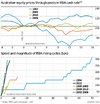Hi,
I'm interested in peoples opinion about the relationship between the (RBA) overnight cash rate and the ASX200 -INDEXASX:XJO. Can you say from a liquidity point of view that the ASX200 goes up when interest rates are reduced ?
Also, I was looking for evidence of INDEXASX:XJO decoupling from the Dow (INDEXDJX:.DJI) , but it seems what ever the American index does the ASX200 does also.
ANy comment ?
regards
David
I'm interested in peoples opinion about the relationship between the (RBA) overnight cash rate and the ASX200 -INDEXASX:XJO. Can you say from a liquidity point of view that the ASX200 goes up when interest rates are reduced ?
Also, I was looking for evidence of INDEXASX:XJO decoupling from the Dow (INDEXDJX:.DJI) , but it seems what ever the American index does the ASX200 does also.
ANy comment ?
regards
David



